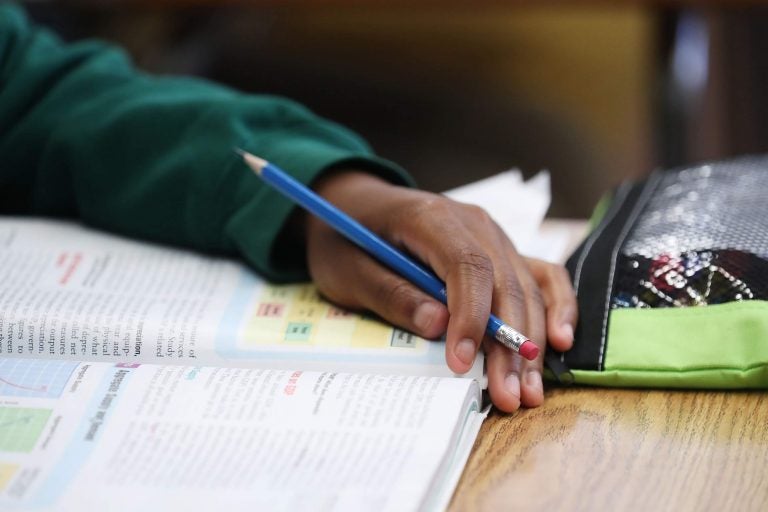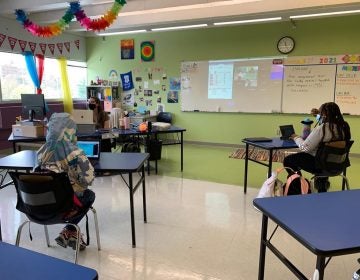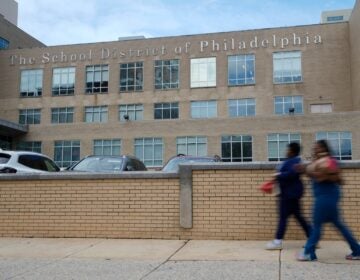Philadelphia won’t use test scores for admissions to selective schools for 2022-23
The policy grew out of necessity — very few students this spring have taken or will take the state test due to the COVID-19 pandemic.

Philadelphia will not use standardized testing to determine admissions to selective middle and high schools for the 2022-23 year. (Karen Pulfer Focht for Chalkbeat)
This article originally appeared on Chalkbeat Philadelphia.
—
Philadelphia will not use standardized testing to determine admissions to selective middle and high schools for the 2022-23 year and is seeking ideas from the public on what criteria should be prioritized.
The policy grew out of necessity — very few students this spring have taken or will take the state test due to the COVID-19 pandemic. This means there are no recent test scores to determine eligibility for the selective schools.
But the decision has implications for the future, and the experience will inform whether the policy will continue.
“We are gathering community input on alternative ways of matching students with good-fit schools by considering different admission requirements,” the school district says on its student placement web page, called “Find Your Fit.” The survey, which is in 10 languages, takes about 10 minutes and can be filled out until June 11.
It asks respondents to rate in relative importance 15 possible indicators, including some already used, such as grades, attendance, interviews, teacher recommendations and auditions. Among other choices are student-generated projects and videos, extracurricular activities, and service and work experience. Earlier standardized test scores and school-based, quarterly benchmark testing in reading and math are also given as choices. The survey also provides space for other ideas.
“As an organization working to address any issues of inequity and fairness, the Office of Enrollment and Placement is looking at the school selection process and determining the best ways to consider students who seek to attend schools with [admissions] criteria,” said district spokeswoman Christina Clark in a statement. “As we move forward with reviewing the policies and practices related to the school selection process from an equity lens, there will likely be changes that are yet to be determined. That’s why we are seeking input.”
Traditionally, students seeking admission to 19 selective admission high schools and five selective middle schools have needed to score in at least the 70th percentile in the state PSSA test in reading and math. For the most selective schools, including Central High School and Julia R. Masterman Laboratory and Demonstration School, the cutoff is the 90th percentile.
There is a growing chorus of activists and educators concerned that the current process, with its heavy reliance on test scores, discriminates against Black and Latino students. According to district data, about a third of the students who meet the minimum selection criteria are Black or Latino, even though those groups make up 70% of the district’s enrollment.
Their representation in the most selective schools is even lower and has precipitously declined in the past decade.
In the 2011-2012 school year, Black students made up 33% of Central and 31% of Masterman. By the 2019-2020 school year, those numbers had dropped to 20% for Central and 15% for Masterman. During that time period, the percentage of Asian American students increased substantially, while the percentage of white students remained about the same.
There are huge differences among racial and ethnic groups in the percentages of eighth grade students who meet the qualifications for selective high schools, ranging from more than half of Asian Americans to just one in ten Black students, according to the district’s most recent report on the admissions process.
These disparities constitute “an area of urgent focus,” the report said.
One of the Board of Education’s five-year targets in its “goals and guardrails” initiative — its effort to concentrate on ways to improve educational opportunity and quality across the district — is to increase Black and Latino representation in these schools from 33.8% to 52% by August 2026. Board members will discuss this at its Thursday meeting. Addressing special admissions is the first goal under the fourth guardrail, which is “dismantle racist practices.”
“I am not an anti-standardized test person,” said board President Joyce Wilkerson. “It’s not the testing per se. What’s problematic is the quality of preparation of children before they get to the test.”
The board has been studying elementary schools to identify those that are considered “off-track,” as measured by benchmark test scores and other academic indicators, with the objective of directing more resources to them. Almost all of these schools are in the poorest neighborhoods and predominantly enroll students of color, while the “on-track” schools, for the most part, enroll more white and middle class students.
Activists applauded the decision to eliminate PSSA scores from consideration during the next admissions cycle, but expressed doubt over whether the step would address all their equity concerns.
Dropping the test for this year “is a good step in the right direction, and was a long time coming,” said Keziah Ridgeway, a teacher at Northeast High School and member of the Caucus of Working Educators and the Melanated Educators Association. “I don’t think testing should be used in any form in the admissions process for Philadelphia high schools. It is discriminatory against students who come from different socioeconomic backgrounds. When you think about testing, it is inherently corrupted. Quite honestly, it is a tool to continue to oppress students of color.”
Last spring, the PSSA was canceled entirely due to the pandemic. So for this year’s selection process the district decided to use older scores — from fifth and sixth grade. It also relaxed the requirement for all As and Bs to allow for one C.
According to a detailed study of this year’s process from the district’s Office of Research and Evaluation, the new rules increased the pool of qualifying eighth graders — from 14% to 20.2%.
The report attributed the jump to the use of two years of data, which gave students “multiple opportunities” to meet the minimum qualifications.
But it also highlighted the huge disparities in qualification rates among the different groups. All racial and ethnic groups saw a higher percentage of students meet the standard — but not to the same degree. The percentage point increases for white and Asian American students were larger than that for Black and Latino students, and the already wide disparities in qualification rates only grew wider.
For instance, 55% of Asian American students qualified this year, compared to 45% in the 2019-20 school year. But just 11% of Black students met the qualifications, up from 7% the year before.
White students increased their qualification rates from 27% to 37% from last year to this year, while the percentage of qualified Latino students rose from 8% to 14%. The rate for multiracial students went from 17% to just under 20%.
Because there are so many more Black and Latino students than white and Asian American ones in the system, the overall pool actually grew somewhat more diverse under this year’s revised system. Still, “the increases in qualification rates did not benefit all students equally,” the report said, concluding: “The district has identified disproportionality in qualification levels as an area of urgent focus [in an effort to] address root causes of inequity in educational opportunities.”
And the data show that even with the changed admissions requirement, little progress was made toward the goal of diversifying the enrollment at the district’s two most sought after schools, Central and Masterman.
Central’s enrollment this past year was 20% Black and 8% Latino, but among the district eighth grade students who have decided to attend Central for ninth grade next year, 14% are Black and 4% are Latino. Those percentages do not account for private and charter school students admitted to Central, who make up about one-third of the incoming ninth grade class, so they could go up.
At Masterman, where all but two of the admitted students come from within the district — usually Masterman middle school — the next class is 36% white, 32% Asian American, 14% Black, 9% Latino, and 9% multiracial.
The inequities go beyond the numbers. The racial reckoning of the past year ignited by George Floyd’s murder at the hands of a Minneapolis police officer also forced a close look at the practices and atmosphere at the two schools.
In July, there was a leak of racist and sexist messages exchanged by some male students. Black alumni began pouring out their experiences with racism and issued statements demanding change — including an overhaul of the admissions process to admit more students of color — which the principals and the district agreed to consider. Many Masterman and Central faculty endorsed the calls for change.
Chalkbeat is a nonprofit news site covering educational change in public schools.

Get daily updates from WHYY News!
WHYY is your source for fact-based, in-depth journalism and information. As a nonprofit organization, we rely on financial support from readers like you. Please give today.






